IT Ethics: Applying Doing Ethics Technique to Early Launch Scenario
VerifiedAdded on 2021/04/21
|6
|1417
|91
Report
AI Summary
This report provides an in-depth analysis of IT ethics, focusing on the application of the Doing Ethics Technique (DET) to an 'Early Launch' scenario. The DET is used to identify ethical and non-ethical issues within the scenario, which involves a project director pressuring a project manager to release software ahead of schedule without encryption. The report details the facts of the situation, including the importance of encryption for data security, and highlights key issues such as the potential compromise of user data and the prioritization of profit over ethical considerations. The analysis identifies stakeholders affected by the decision, including the project manager, users, the organization, and the client. The report applies deontological ethical theory to assess the morality of the situation, concluding that delivering the software without encryption is ethically incorrect. Various options are discussed, with the recommendation that the project director prioritize software security over an early launch. The report concludes that companies should prioritize security and ethical considerations over any potential gains.
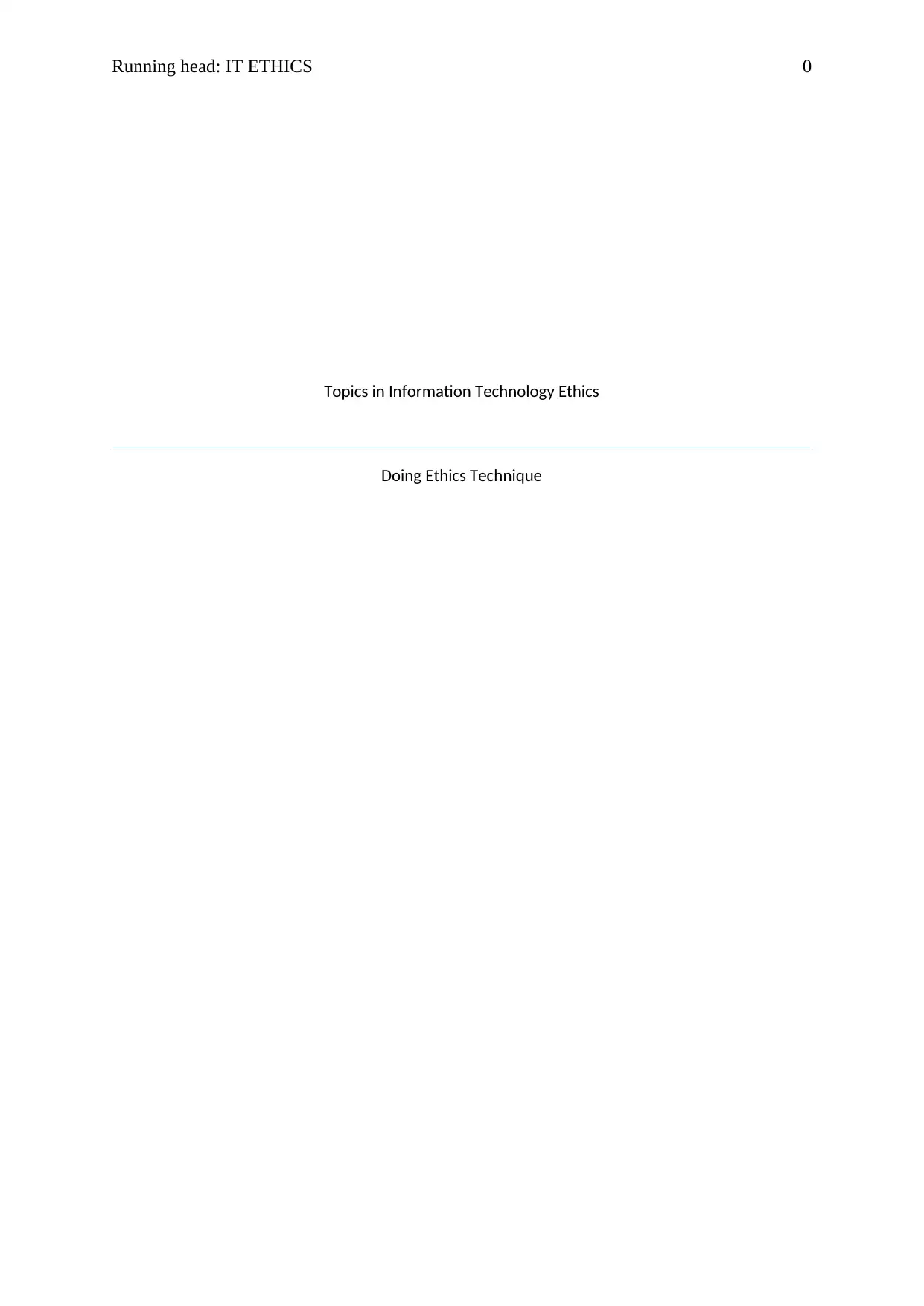
Running head: IT ETHICS 0
Topics in Information Technology Ethics
Doing Ethics Technique
Topics in Information Technology Ethics
Doing Ethics Technique
Paraphrase This Document
Need a fresh take? Get an instant paraphrase of this document with our AI Paraphraser
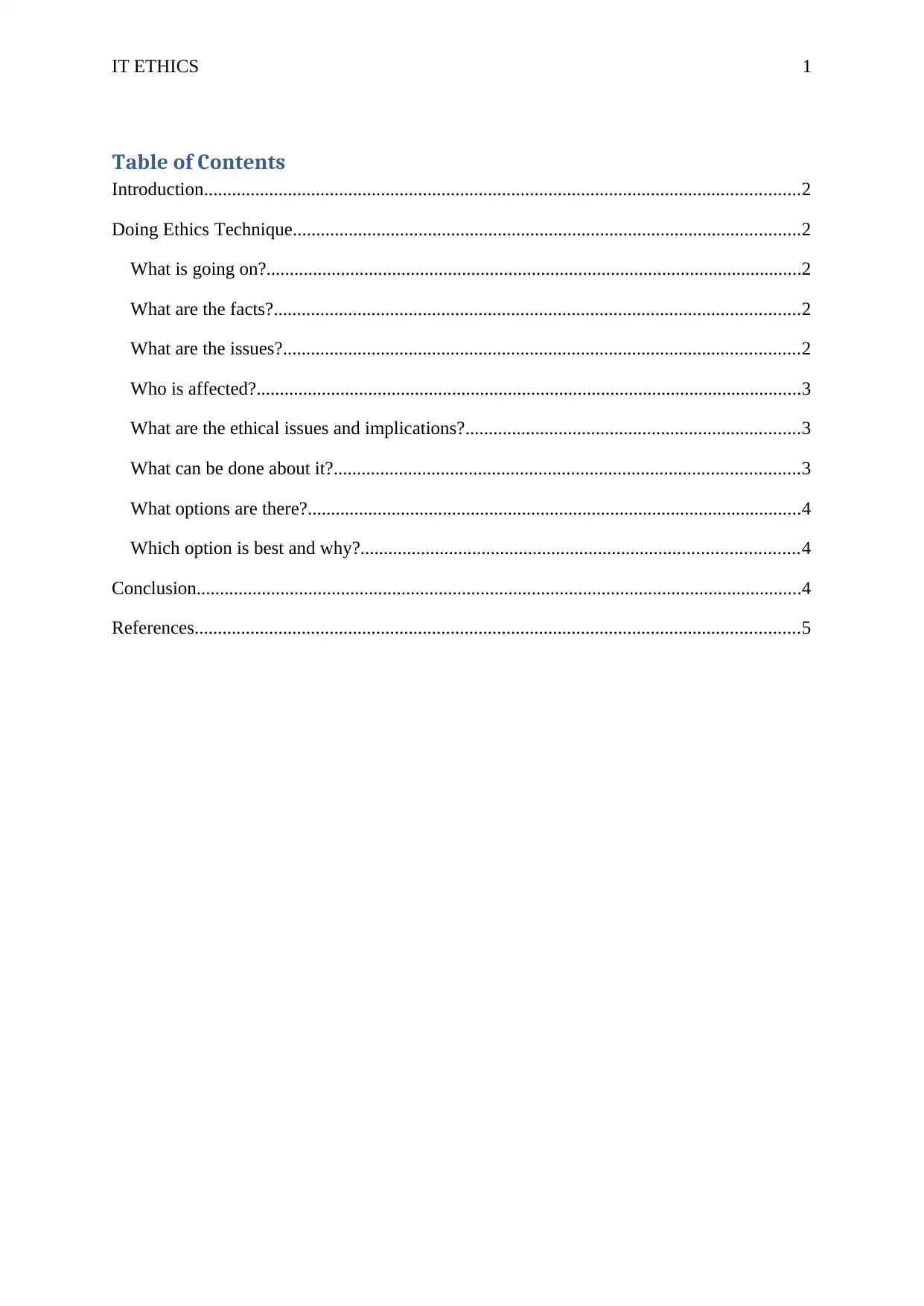
IT ETHICS 1
Table of Contents
Introduction................................................................................................................................2
Doing Ethics Technique.............................................................................................................2
What is going on?...................................................................................................................2
What are the facts?.................................................................................................................2
What are the issues?...............................................................................................................2
Who is affected?.....................................................................................................................3
What are the ethical issues and implications?........................................................................3
What can be done about it?....................................................................................................3
What options are there?..........................................................................................................4
Which option is best and why?..............................................................................................4
Conclusion..................................................................................................................................4
References..................................................................................................................................5
Table of Contents
Introduction................................................................................................................................2
Doing Ethics Technique.............................................................................................................2
What is going on?...................................................................................................................2
What are the facts?.................................................................................................................2
What are the issues?...............................................................................................................2
Who is affected?.....................................................................................................................3
What are the ethical issues and implications?........................................................................3
What can be done about it?....................................................................................................3
What options are there?..........................................................................................................4
Which option is best and why?..............................................................................................4
Conclusion..................................................................................................................................4
References..................................................................................................................................5
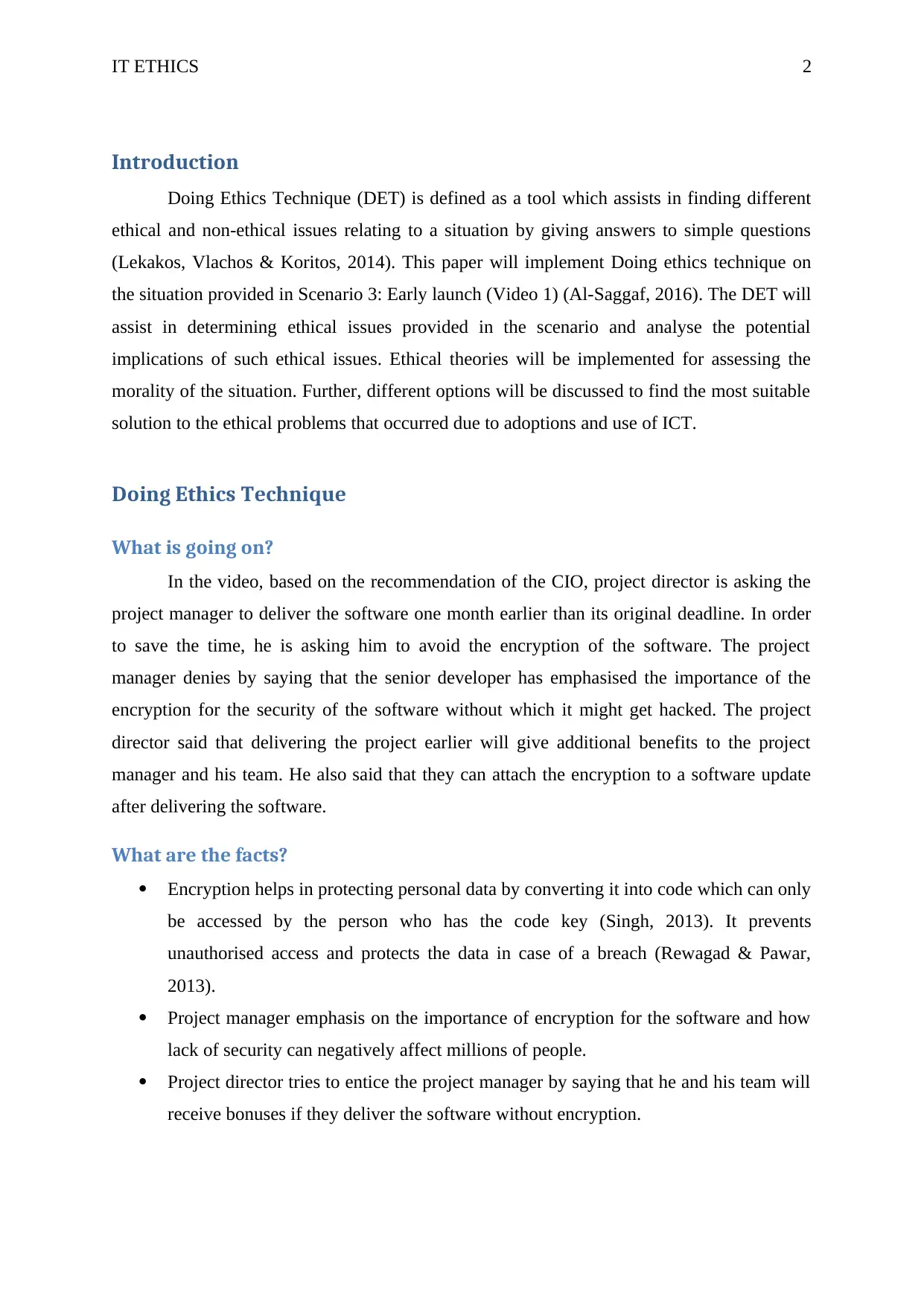
IT ETHICS 2
Introduction
Doing Ethics Technique (DET) is defined as a tool which assists in finding different
ethical and non-ethical issues relating to a situation by giving answers to simple questions
(Lekakos, Vlachos & Koritos, 2014). This paper will implement Doing ethics technique on
the situation provided in Scenario 3: Early launch (Video 1) (Al-Saggaf, 2016). The DET will
assist in determining ethical issues provided in the scenario and analyse the potential
implications of such ethical issues. Ethical theories will be implemented for assessing the
morality of the situation. Further, different options will be discussed to find the most suitable
solution to the ethical problems that occurred due to adoptions and use of ICT.
Doing Ethics Technique
What is going on?
In the video, based on the recommendation of the CIO, project director is asking the
project manager to deliver the software one month earlier than its original deadline. In order
to save the time, he is asking him to avoid the encryption of the software. The project
manager denies by saying that the senior developer has emphasised the importance of the
encryption for the security of the software without which it might get hacked. The project
director said that delivering the project earlier will give additional benefits to the project
manager and his team. He also said that they can attach the encryption to a software update
after delivering the software.
What are the facts?
Encryption helps in protecting personal data by converting it into code which can only
be accessed by the person who has the code key (Singh, 2013). It prevents
unauthorised access and protects the data in case of a breach (Rewagad & Pawar,
2013).
Project manager emphasis on the importance of encryption for the software and how
lack of security can negatively affect millions of people.
Project director tries to entice the project manager by saying that he and his team will
receive bonuses if they deliver the software without encryption.
Introduction
Doing Ethics Technique (DET) is defined as a tool which assists in finding different
ethical and non-ethical issues relating to a situation by giving answers to simple questions
(Lekakos, Vlachos & Koritos, 2014). This paper will implement Doing ethics technique on
the situation provided in Scenario 3: Early launch (Video 1) (Al-Saggaf, 2016). The DET will
assist in determining ethical issues provided in the scenario and analyse the potential
implications of such ethical issues. Ethical theories will be implemented for assessing the
morality of the situation. Further, different options will be discussed to find the most suitable
solution to the ethical problems that occurred due to adoptions and use of ICT.
Doing Ethics Technique
What is going on?
In the video, based on the recommendation of the CIO, project director is asking the
project manager to deliver the software one month earlier than its original deadline. In order
to save the time, he is asking him to avoid the encryption of the software. The project
manager denies by saying that the senior developer has emphasised the importance of the
encryption for the security of the software without which it might get hacked. The project
director said that delivering the project earlier will give additional benefits to the project
manager and his team. He also said that they can attach the encryption to a software update
after delivering the software.
What are the facts?
Encryption helps in protecting personal data by converting it into code which can only
be accessed by the person who has the code key (Singh, 2013). It prevents
unauthorised access and protects the data in case of a breach (Rewagad & Pawar,
2013).
Project manager emphasis on the importance of encryption for the software and how
lack of security can negatively affect millions of people.
Project director tries to entice the project manager by saying that he and his team will
receive bonuses if they deliver the software without encryption.
⊘ This is a preview!⊘
Do you want full access?
Subscribe today to unlock all pages.

Trusted by 1+ million students worldwide
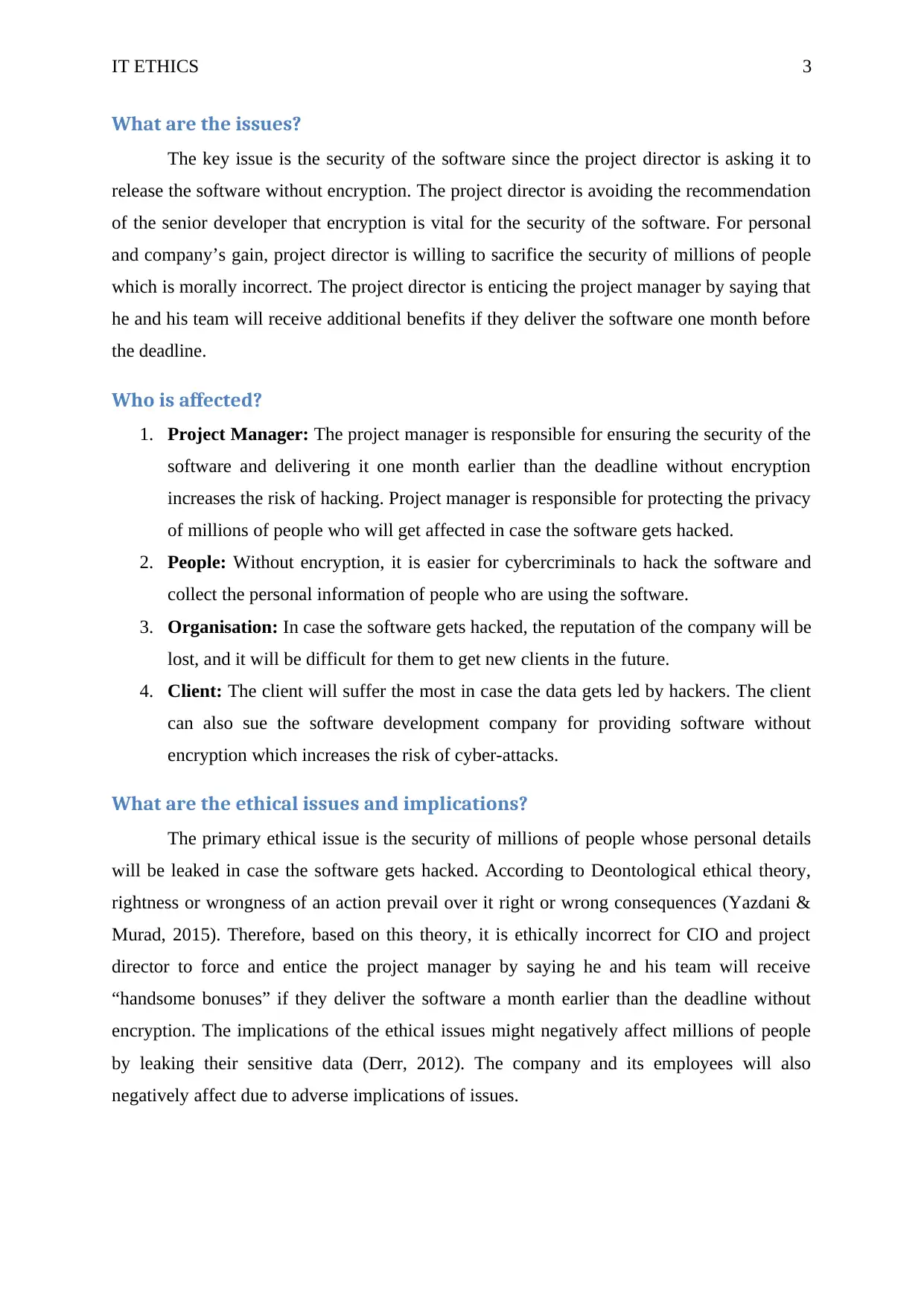
IT ETHICS 3
What are the issues?
The key issue is the security of the software since the project director is asking it to
release the software without encryption. The project director is avoiding the recommendation
of the senior developer that encryption is vital for the security of the software. For personal
and company’s gain, project director is willing to sacrifice the security of millions of people
which is morally incorrect. The project director is enticing the project manager by saying that
he and his team will receive additional benefits if they deliver the software one month before
the deadline.
Who is affected?
1. Project Manager: The project manager is responsible for ensuring the security of the
software and delivering it one month earlier than the deadline without encryption
increases the risk of hacking. Project manager is responsible for protecting the privacy
of millions of people who will get affected in case the software gets hacked.
2. People: Without encryption, it is easier for cybercriminals to hack the software and
collect the personal information of people who are using the software.
3. Organisation: In case the software gets hacked, the reputation of the company will be
lost, and it will be difficult for them to get new clients in the future.
4. Client: The client will suffer the most in case the data gets led by hackers. The client
can also sue the software development company for providing software without
encryption which increases the risk of cyber-attacks.
What are the ethical issues and implications?
The primary ethical issue is the security of millions of people whose personal details
will be leaked in case the software gets hacked. According to Deontological ethical theory,
rightness or wrongness of an action prevail over it right or wrong consequences (Yazdani &
Murad, 2015). Therefore, based on this theory, it is ethically incorrect for CIO and project
director to force and entice the project manager by saying he and his team will receive
“handsome bonuses” if they deliver the software a month earlier than the deadline without
encryption. The implications of the ethical issues might negatively affect millions of people
by leaking their sensitive data (Derr, 2012). The company and its employees will also
negatively affect due to adverse implications of issues.
What are the issues?
The key issue is the security of the software since the project director is asking it to
release the software without encryption. The project director is avoiding the recommendation
of the senior developer that encryption is vital for the security of the software. For personal
and company’s gain, project director is willing to sacrifice the security of millions of people
which is morally incorrect. The project director is enticing the project manager by saying that
he and his team will receive additional benefits if they deliver the software one month before
the deadline.
Who is affected?
1. Project Manager: The project manager is responsible for ensuring the security of the
software and delivering it one month earlier than the deadline without encryption
increases the risk of hacking. Project manager is responsible for protecting the privacy
of millions of people who will get affected in case the software gets hacked.
2. People: Without encryption, it is easier for cybercriminals to hack the software and
collect the personal information of people who are using the software.
3. Organisation: In case the software gets hacked, the reputation of the company will be
lost, and it will be difficult for them to get new clients in the future.
4. Client: The client will suffer the most in case the data gets led by hackers. The client
can also sue the software development company for providing software without
encryption which increases the risk of cyber-attacks.
What are the ethical issues and implications?
The primary ethical issue is the security of millions of people whose personal details
will be leaked in case the software gets hacked. According to Deontological ethical theory,
rightness or wrongness of an action prevail over it right or wrong consequences (Yazdani &
Murad, 2015). Therefore, based on this theory, it is ethically incorrect for CIO and project
director to force and entice the project manager by saying he and his team will receive
“handsome bonuses” if they deliver the software a month earlier than the deadline without
encryption. The implications of the ethical issues might negatively affect millions of people
by leaking their sensitive data (Derr, 2012). The company and its employees will also
negatively affect due to adverse implications of issues.
Paraphrase This Document
Need a fresh take? Get an instant paraphrase of this document with our AI Paraphraser
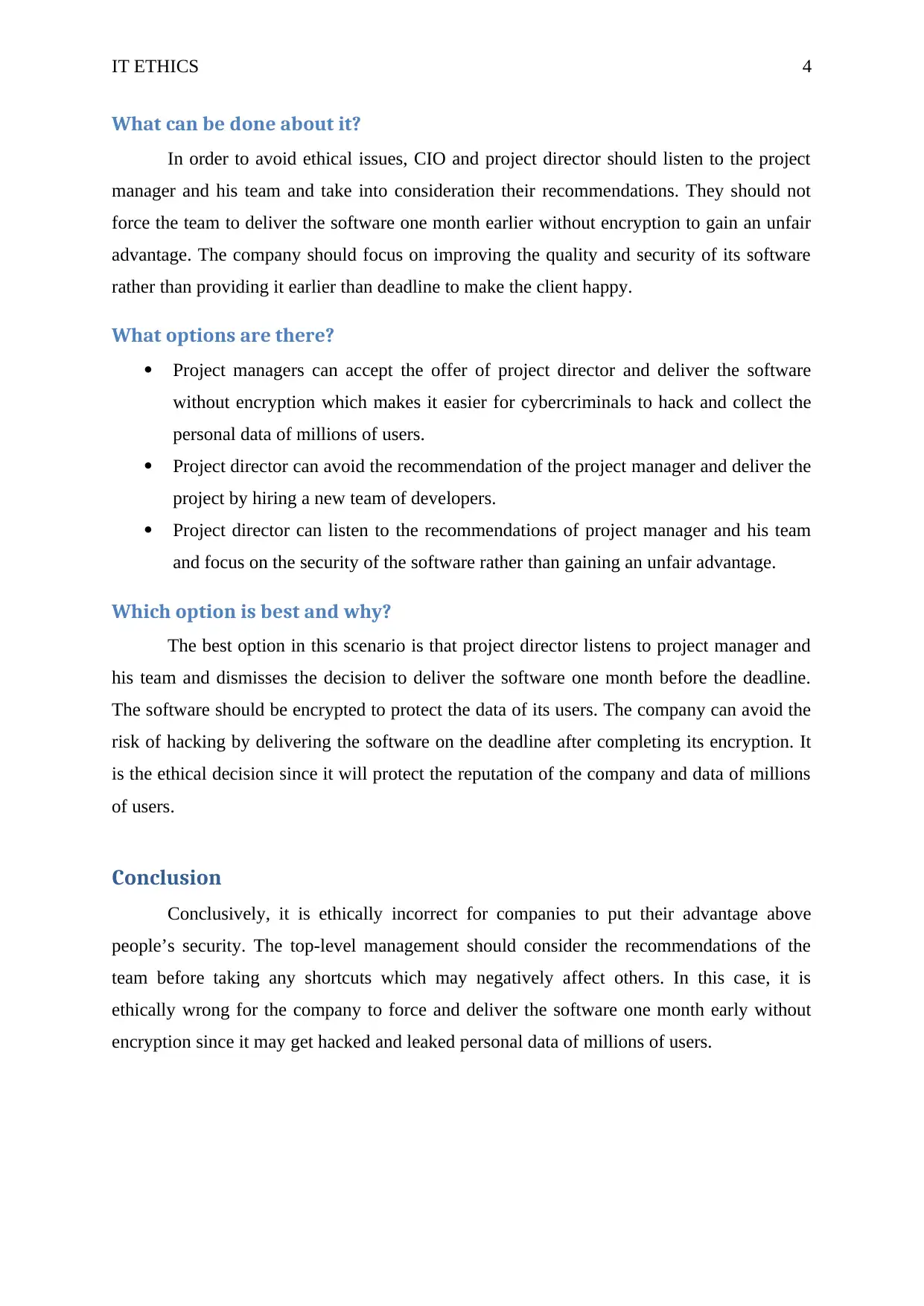
IT ETHICS 4
What can be done about it?
In order to avoid ethical issues, CIO and project director should listen to the project
manager and his team and take into consideration their recommendations. They should not
force the team to deliver the software one month earlier without encryption to gain an unfair
advantage. The company should focus on improving the quality and security of its software
rather than providing it earlier than deadline to make the client happy.
What options are there?
Project managers can accept the offer of project director and deliver the software
without encryption which makes it easier for cybercriminals to hack and collect the
personal data of millions of users.
Project director can avoid the recommendation of the project manager and deliver the
project by hiring a new team of developers.
Project director can listen to the recommendations of project manager and his team
and focus on the security of the software rather than gaining an unfair advantage.
Which option is best and why?
The best option in this scenario is that project director listens to project manager and
his team and dismisses the decision to deliver the software one month before the deadline.
The software should be encrypted to protect the data of its users. The company can avoid the
risk of hacking by delivering the software on the deadline after completing its encryption. It
is the ethical decision since it will protect the reputation of the company and data of millions
of users.
Conclusion
Conclusively, it is ethically incorrect for companies to put their advantage above
people’s security. The top-level management should consider the recommendations of the
team before taking any shortcuts which may negatively affect others. In this case, it is
ethically wrong for the company to force and deliver the software one month early without
encryption since it may get hacked and leaked personal data of millions of users.
What can be done about it?
In order to avoid ethical issues, CIO and project director should listen to the project
manager and his team and take into consideration their recommendations. They should not
force the team to deliver the software one month earlier without encryption to gain an unfair
advantage. The company should focus on improving the quality and security of its software
rather than providing it earlier than deadline to make the client happy.
What options are there?
Project managers can accept the offer of project director and deliver the software
without encryption which makes it easier for cybercriminals to hack and collect the
personal data of millions of users.
Project director can avoid the recommendation of the project manager and deliver the
project by hiring a new team of developers.
Project director can listen to the recommendations of project manager and his team
and focus on the security of the software rather than gaining an unfair advantage.
Which option is best and why?
The best option in this scenario is that project director listens to project manager and
his team and dismisses the decision to deliver the software one month before the deadline.
The software should be encrypted to protect the data of its users. The company can avoid the
risk of hacking by delivering the software on the deadline after completing its encryption. It
is the ethical decision since it will protect the reputation of the company and data of millions
of users.
Conclusion
Conclusively, it is ethically incorrect for companies to put their advantage above
people’s security. The top-level management should consider the recommendations of the
team before taking any shortcuts which may negatively affect others. In this case, it is
ethically wrong for the company to force and deliver the software one month early without
encryption since it may get hacked and leaked personal data of millions of users.
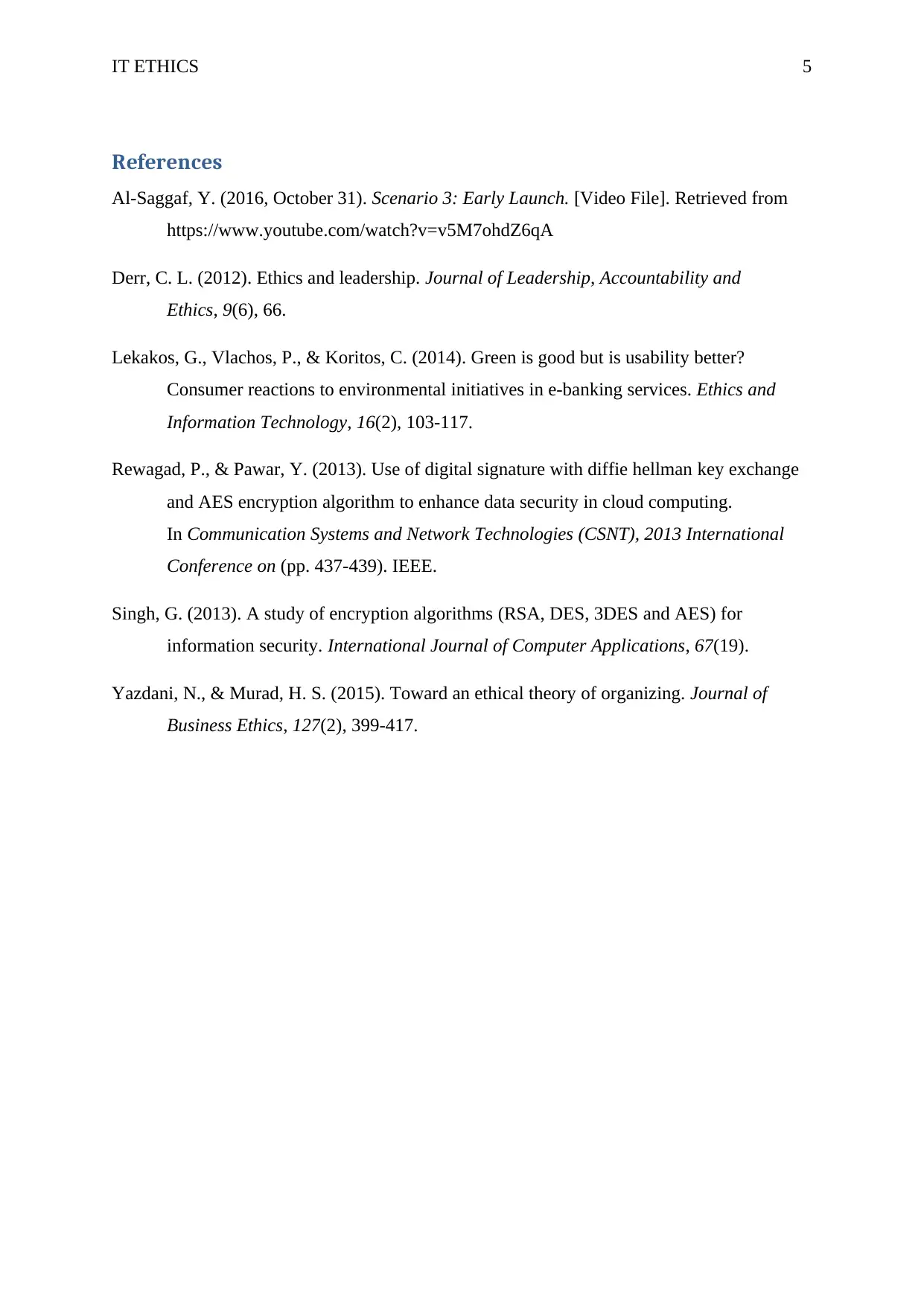
IT ETHICS 5
References
Al-Saggaf, Y. (2016, October 31). Scenario 3: Early Launch. [Video File]. Retrieved from
https://www.youtube.com/watch?v=v5M7ohdZ6qA
Derr, C. L. (2012). Ethics and leadership. Journal of Leadership, Accountability and
Ethics, 9(6), 66.
Lekakos, G., Vlachos, P., & Koritos, C. (2014). Green is good but is usability better?
Consumer reactions to environmental initiatives in e-banking services. Ethics and
Information Technology, 16(2), 103-117.
Rewagad, P., & Pawar, Y. (2013). Use of digital signature with diffie hellman key exchange
and AES encryption algorithm to enhance data security in cloud computing.
In Communication Systems and Network Technologies (CSNT), 2013 International
Conference on (pp. 437-439). IEEE.
Singh, G. (2013). A study of encryption algorithms (RSA, DES, 3DES and AES) for
information security. International Journal of Computer Applications, 67(19).
Yazdani, N., & Murad, H. S. (2015). Toward an ethical theory of organizing. Journal of
Business Ethics, 127(2), 399-417.
References
Al-Saggaf, Y. (2016, October 31). Scenario 3: Early Launch. [Video File]. Retrieved from
https://www.youtube.com/watch?v=v5M7ohdZ6qA
Derr, C. L. (2012). Ethics and leadership. Journal of Leadership, Accountability and
Ethics, 9(6), 66.
Lekakos, G., Vlachos, P., & Koritos, C. (2014). Green is good but is usability better?
Consumer reactions to environmental initiatives in e-banking services. Ethics and
Information Technology, 16(2), 103-117.
Rewagad, P., & Pawar, Y. (2013). Use of digital signature with diffie hellman key exchange
and AES encryption algorithm to enhance data security in cloud computing.
In Communication Systems and Network Technologies (CSNT), 2013 International
Conference on (pp. 437-439). IEEE.
Singh, G. (2013). A study of encryption algorithms (RSA, DES, 3DES and AES) for
information security. International Journal of Computer Applications, 67(19).
Yazdani, N., & Murad, H. S. (2015). Toward an ethical theory of organizing. Journal of
Business Ethics, 127(2), 399-417.
⊘ This is a preview!⊘
Do you want full access?
Subscribe today to unlock all pages.

Trusted by 1+ million students worldwide
1 out of 6
Related Documents
Your All-in-One AI-Powered Toolkit for Academic Success.
+13062052269
info@desklib.com
Available 24*7 on WhatsApp / Email
![[object Object]](/_next/static/media/star-bottom.7253800d.svg)
Unlock your academic potential
Copyright © 2020–2025 A2Z Services. All Rights Reserved. Developed and managed by ZUCOL.





